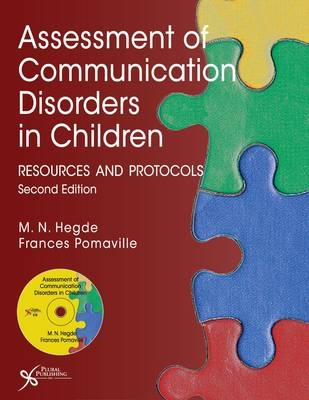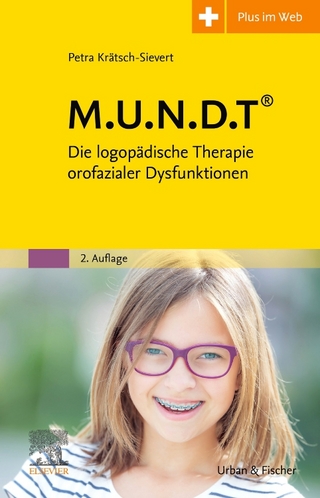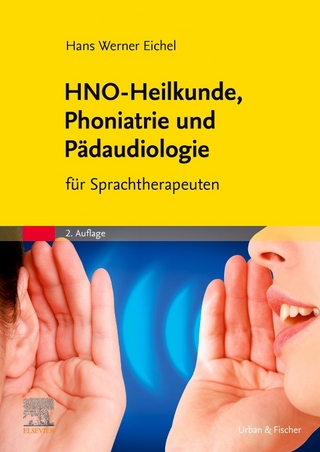
Assessment of Communication Disorders in Children
Plural Publishing Inc (Verlag)
978-1-59756-487-8 (ISBN)
- Titel z.Zt. nicht lieferbar
- Versandkostenfrei innerhalb Deutschlands
- Auch auf Rechnung
- Verfügbarkeit in der Filiale vor Ort prüfen
- Artikel merken
This second edition of a high-demand text offers a unique combination of scholarly information, invaluable resources, and time-saving protocols on assessment of communication disorders in children. Most resource books offer limited research and scholarly information, thus making them unsuitable as textbooks for academic courses on assessment and diagnosis. Similarly, most traditional textbooks do not include practical, easy-to-use, and time-saving resources and protocols that the practicing clinicians can readily use during assessment sessions. By combining the strengths of traditional textbooks and newer assessment resources and protocols, this one-of-a kind book offers a single, comprehensive source that is suitable as a textbook and useful as a practical clinical resource.While combining scholarly information needed for academic courses and practical tools for clinical assessment, this innovative book: Covers the full range of communication disorders in children, including nonverbal or minimally verbal children Includes an extensive discussion of issues in using standardized tests along with detailed information on psychometric principles Offers a detailed discussion of alternative assessment approaches that minimize the problems inherent to standardized tests Describes a new, comprehensive, and integrated assessment approach that derives its strengths from the traditional as well as several alternative approaches Provides an updated and thorough discussion of multicultural issues in assessing communication disorders in children Integrates multicultural assessment procedures into the assessment protocols offered for all communication disorders Contains two chapters for each disorder: one on resources that offers scholarly and research background on the disorder and one on resources that describe practical procedures and protocols that save preparation time and effort for the clinician and makes it possible to use as a textbook as well as a clinical resource book
M. Hegde, Ph.D. M. N. Hegde, Ph.D. is Professor of Speech-Language Pathology in the Department of Communicative Disorders at California State University, Fresno. A highly regarded author in speech-language pathology, his books include leading texts in academic courses and valuable resources for clinicians. His books have been used in worldwide in speech-language pathology programs. Frances Pomaville, M.A. A speech-language pathologist for over 20 years, Frances Pomaville, M. A., is a lecturer in the Communicative Disorders and Deaf Studies Department at California State University, Fresno. She teaches undergraduate and graduate level courses in the areas of diagnostic procedures, anatomy and physiology, fluency, voice, craniofacial anomalies, traumatic brain injury, and dysphagia. She also provides supervision to graduate students completing their clinical practicum. Prior to accepting a faculty position at California State University, Fresno, Ms. Pomaville was the Director of Clinical Services at San Joaquin Valley Rehabilitation Hospital. Prior to that she had extensive experience as a speech-language pathologist in private practice, acute care settings, and inpatient and outpatient rehabilitation settings. Ms. Pomaville has also worked with children in the public school setting as an itinerant speech-language pathologist, and she spent several years working with students in a special education program for deaf and hard of hearing children. Ms. Pomaville is a registered mentor with the International Association of Laryngectomees (IAL), and served as the moderator for the Central California Lost Chord Club for over 10 years. She has presented multiple workshops for District 5 of the California Speech-Language-Hearing Association and for the local National Student Speech-Language-Hearing Association on such topics as laryngectomee rehabilitation, aphasia, brain injury rehabilitation, and dysphagia. Ms. Pomaville is a recipient of the Outstanding Achievement Award from District 5 of the California Speech-Language-Hearing Association. Ms. Pomaville received her bachelor's and master's degrees from California State University, Fresno, and is in the process of completing a doctoral degree in General Human Services.
Table of Contents Preface xi Creating Child-Specific Assessment Packages with Protocols on the CD xiii Part I. Foundations of Assessment 1 Chapter 1. Assessment in Speech-Language Pathology 3 Assessment, Evaluation, and Diagnosis 4 Written Case History 6 The Initial Clinical Interview 8 Hearing Screening 10 Orofacial Examination 10 Diadochokinetic Tasks 11 Speech-Language Sample 11 Standardized Assessment Instruments 12 Alternative and Integrated Assessment Procedures 12 Assessment of Nonverbal and Minimally Verbal Children 13 Assessment of Literacy Skills 13 Stimulability 13 Postassessment Counseling 14 Assessment Report 14 Chapter 2. Common Assessment Protocols 17 Child Case History Protocol 19 Developmental Milestones from 0 to 4 Years of Age 24 Instructions for Conducting the Orofacial Examination: 27 Observations and Implications Orofacial Examination and Hearing Screening Protocol 32 Diadochokinetic Assessment Protocol 35 Assessment Report Outline 36 Chapter 3. Standardized Assessment 43 Standardized and Norm-Referenced Tests 44 Test Construction 49 Reliability 51 Validity 54 Questionnaires and Developmental Inventories 58 Strengths of Standardized Tests 60 Limitations of Standardized Tests 62 Prudent Use of Standardized Tests 64 Assessment in a Multicultural Society 67 Chapter 4. Assessment of Ethnoculturally Diverse Children 69 Assessment in Ethnoculturally Diverse Societies 70 Can Speech-Language Assessment Be Culture-Free? 71 Limitations of Standardized Tests in Assessing Ethnoculturally Diverse Children 73 Assessment of African American Children 77 Assessment of Bilingual Children 88 Traditional and Alternative Assessment Approaches 105 Chapter 5. Alternative and Integrated Assessment Approaches 107 Behavioral Assessment 108 Criterion-Referenced and Client-Specific Assessment 120 Authentic Assessment 122 Dynamic Assessment 126 Portfolio Assessment 130 Efforts at Combining Different Approaches 135 A Comprehensive and Integrated Assessment Approach 136 Part II. A ssessment of Speech Sound Production 143 Chapter 6. Assessment of Speech Sound Production: Resources 145 Overview of Speech Sound Production 146 Speech Sounds and Their Acquisition 150 Phonologic Analysis of Speech Sounds 154 Speech Sound Disorders 158 Dysarthria Associated with Cerebral Palsy 162 Childhood Apraxia of Speech 164 Overview of Assessment of Speech Sound Production 165 Screening for Speech Sound Disorders 167 Standardized Tests of Articulation and Phonologic Skills 168 Spontaneous Speech Sample 170 Stimulability of Speech Sounds 173 Assessment of Speech Sound Production in Ethnoculturally Diverse Children 175 Analysis and Integration of Assessment Results 176 Diagnostic Criteria and Differential Diagnosis 178 Postassessment Counseling 180 Chapter 7. Assessment of Speech Sound Production: Protocols 185 Note on Common Protocols 186 Note on Specific Protocols 186 Interview Protocol 187 Speech Sample Analysis Protocol 189 Phonetic Inventory Analysis Protocol 192 Manner-Place-Voicing Analysis Protocol 193 Consonant Clusters Inventory Protocol 194 Phonologic Pattern Assessment Protocol 197 Speech Sound Stimulability Assessment Protocol 199 Childhood Apraxia of Speech Assessment Protocol 207 Dysarthric Speech Assessment Protocol 208 Selected Multicultural Assessment Protocols 209 African American English: Speech Sound Assessment Protocol 210 Asian American English: Speech Sound Assessment Protocol 213 Spanish-Influenced English: Speech Sound Assessment Protocol 215 Part III. A ssessment of Language Skills in Children 217 Chapter 8. Assessment of Language Skills in Children: Resources 219 Overview of Language 220 Overview of Verbal Behavior 231 Prevalence of Child Language Disorders 232 Overview of Child Language Disorders 232 Clinical Conditions Associated with Language Disorders 234 Specific Language Impairment 237 Factors Related to Language Disorders 239 Overview of Assessment of Child Language Disorders 240 Screening for Language Disorders 242 Language Sampling 242 Integrating Alternative Assessment Techniques 247 Assessment of Language Understanding 249 Assessment of Other Aspects of Communication 250 Standardized Language Diagnostic Tests 251 Assessment of Language Skills in Ethnoculturally Diverse Children 251 Analysis and Integration of Assessment Results 255 Differential Diagnosis of Child Language Disorders 258 Postassessment Counseling 259 Chapter 9. Assessment of Language Skills: Protocols 263 Note on Common Protocols 264 Note on Specific Protocols 264 Interview Protocol 265 Normal Language Assessment Protocol 270 Language Sample Transcription Protocol 277 Language Sample Analysis Protocol: Syntactic, Morphologic, 281 and Pragmatic Skills Task-Specific Assessment Protocol for Basic Vocabulary 282 Task-Specific Assessment Protocol for Grammatic Morphemes 285 Task-Specific Assessment Protocol for Conversational Skills 289 Behavioral Assessment Protocol 292 Selected Multicultural Assessment Protocols 300 African American English (AAE): Language Assessment Protocol 301 Asian American English: Language Assessment Protocol 303 Spanish-Influenced English: Language Assessment Protocol 305 Part IV. A ssessment of Fluency 307 Chapter 10. Assessment of Fluency Disorders: Resources 309 Descriptions of Fluency 310 Measurement of Fluency 311 Disorders of Fluency 311 Stuttering 312 Ethnocultural Variables and Stuttering 314 Definition and Measurement of Stuttering 315 Additional Features of Stuttering 326 Cluttering 333 Analysis and Integration of Assessment Results 335 Differential Diagnosis of Fluency Disorders 335 Postassessment Counseling 337 Chapter 11. Assessment of Fluency Disorders: Protocols 341 Note on Common Protocols 342 Note on Specific Protocols 342 Interview Protocol 343 Dysfluency Measurement Protocol 348 Associated Motor Behaviors Assessment Protocol 349 Avoidance Behaviors Assessment Protocol 350 Cluttering Assessment Protocol 353 Part V. A ssessment of Voice 355 Chapter 12. Assessment of Voice: Resources 357 Prevalence of Voice Disorders in Children 358 Children's Voice Disorders 359 Etiologic Factors Associated with Voice Disorders 365 The Need for Medical Evaluation 373 Assessment of Voice Production 374 Instrumental Evaluation 375 Laryngeal Imaging 377 Clinical Assessment of Voice 378 Stimulability of Voice Production 385 Assessment of Voice in Ethnoculturally Diverse Children 386 Analysis and Integration of Assessment Results 387 Differential Diagnosis of Voice Disorders 388 Postassessment Counseling 390 Chapter 13. Assessment of Voice: Protocols 395 Note on Common Protocols 396 Note on Specific Protocols 396 Interview Protocol 397 Vocal Abuse and Misuse Inventory 400 Child Voice Evaluation Protocol 402 Resonance and Velopharyngeal Function Assessment Protocol 406 Voice Stimulability Assessment Protocol 409 Part VI. A ssessment of Nonverbal and Minimally Verbal Children 411 Chapter 14. Assessment of Nonverbal and Minimally 413 Verbal Children: Resources An Overview of Nonverbal and Minimally Verbal Children 414 The Assessment Team 415 Assessment of Nonverbal or Minimally Verbal Children 419 Case History and Interview 419 Orofacial Examination and Hearing Screening 420 Standardized and Criterion-Referenced Instruments 420 Systematic Quantitative and Qualitative Observations of 423 Nonverbal Communication Assessment of Receptive Language 426 Assessment of Verbalizations 427 Analysis and Integration of Assessment Results 427 Prognosis for Developing Verbal Communication 429 Postassessment Counseling 430 Chapter 15. Assessment of Nonverbal and Minimally 433 Verbal Children: Protocols Note on Common Protocols 434 Note on Specific Protocols 434 Interview Protocol 435 Verbalizations of Nonverbal or Minimally Verbal Children: 440 Assessment Protocol Nonverbal Expressive Communication: Qualitative and Quantitative 445 Assessment Protocol Nonverbal Receptive Communication: Qualitative and Quantitative 451 Assessment Protocol Interaction Between Communicative Partners and the Child: 456 Assessment Protocol Chapter 16. Assessment for Augmentative and Alternative 459 Communication Systems The Three Phases of AAC System Assessment 460 The Role of Speech-Language Pathologists 461 Resources for the Clinician 462 Historical Perspective 463 Revised Participation Model 464 Analysis and Integration of Assessment Results 476 Postassessment Counseling 477 Part VII. Literacy 481 Chapter 17. A Primer on Literacy Assessment 483 Language Disorders and Literacy Problems 484 Emergent Literacy 486 Emergent Literacy Skill Acquisition 488 Assessment of Emergent Literacy Skills 491 Assessment of Reading and Writing 498 References 507 Index 535
| Erscheint lt. Verlag | 22.8.2012 |
|---|---|
| Zusatzinfo | b/w illustrations |
| Verlagsort | San Diego |
| Sprache | englisch |
| Maße | 216 x 279 mm |
| Gewicht | 1315 g |
| Themenwelt | Medizin / Pharmazie ► Gesundheitsfachberufe ► Logopädie |
| Medizin / Pharmazie ► Medizinische Fachgebiete ► Pädiatrie | |
| ISBN-10 | 1-59756-487-7 / 1597564877 |
| ISBN-13 | 978-1-59756-487-8 / 9781597564878 |
| Zustand | Neuware |
| Informationen gemäß Produktsicherheitsverordnung (GPSR) | |
| Haben Sie eine Frage zum Produkt? |
aus dem Bereich


